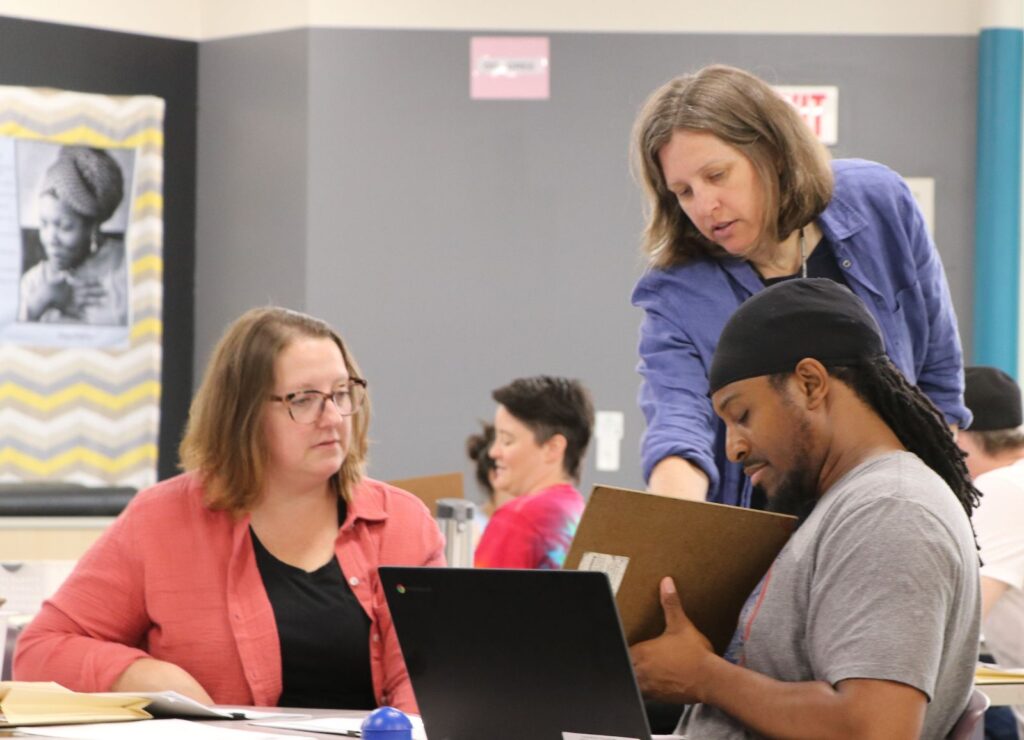
Megan Brainard (left) of Sacramento Elementary and Brian Howelton of Prescott Elementary practice techniques to teach early literacy with trainer Rickie Woolley on Aug. 21 during the Parkrose School District’s Teachers Academy. (Photo by Jake Arnold, OSBA)
An instructor stood before a Parkrose classroom board last week tracing with her finger simple words.
Another instructor went around the room helping the 18 adults as they followed along blending the letters out loud. Ccccaaatttt, ssssaaaatttt droned the room.
With this hands-on training, the educators were learning how to use “structured literacy” to more efficiently teach young students how to read.
It’s back-to-school time in Oregon. Teachers are getting ready as students return to classrooms around the state from mid-August into early September.
Parkrose starts Tuesday, Sept. 3. The Portland-area district’s “Teachers Academy” Aug. 19-23 gave new and experienced educators more tools to launch the school year right.
Tabitha Hunt, a third-year teacher preparing for her first year teaching second grade, attended the academy. She said her teacher preparation program did not included much on how to structure literacy lessons.
“This is definitely the ‘how-to,’” she said.
Oregon is gearing up for an intense legislative session discussion in 2025 about what schools need to offer a high-quality education to all students. The Teachers Academy is largely funded by the Legislature’s additional education investments in recent years, giving Parkrose a means to address challenges such as teacher morale and pay, Oregon’s below average school-year length and students’ literacy levels.
The Teachers Academy offers paid noncontract school days for educators to receive vital training so they don’t have to miss classroom time during the school year, according to Superintendent Michael Lopes Serrao. The academy operates the week before teachers officially return and is voluntary.
“It’s a jumpstart,” said Lopes Serrao. “It provides our kids with teachers who are better prepared and ready to relate to students first thing.”
The academy includes sessions for teachers to get acquainted with each other and the district if they are new. The core of the week offers two training strands: a course on year-long planning strategies open to all teachers and a literacy course aimed at elementary teachers but applicable to any teacher working with students still learning to read.
The Teachers Academy started with just high school teachers after the district received funding from Measure 98, which created the High School Success Fund in 2016 to increase graduation rates and set students up for success after high school.
With funds from the 2019 Student Success Act, the district was able to include elementary teachers, according to Lopes Serrao. The act, which education advocates including OSBA fought vigorously for, aims to invest roughly $1 billion a year in education.
The Early Literacy Success Initiative is paying for the early literacy training that is new at the academy this year. The initiative, established in 2023, will offer more than $90 million to schools this biennium.
“Structured literacy” is a research-based instruction method that can be embedded in any curriculum. It relies on teachers’ explaining and modeling foundational skills such as phonics in a systematic way. The academy trainers called on participants to act as both instructors and students so they could practice the teaching approach.
Lopes Serrao said the academy would not be possible without the funding from the Student Success Act and the Early Literacy Success Initiative. He said dependable funding has helped the academy grow and take hold with his teaching community.
Teacher collaboration time is a “deep need for our education system,” Lopes Serrao said, but Parkrose lacks the funding to create “a more permanent solution.”
Parkrose faced a budget deficit this year and last and had to dip into savings and grant money to maintain staff. Without an adequate State School Fund in 2025, the academy could be at risk, Lopes Serrao said.
“When you’re having to cut, people start looking at those things as extras,” he said. “I’m just trying to create a new foundation for what we would ideally see for our staff and kids.”
Parkrose has offered literacy training during the school year in the past, but that has several drawbacks. Teachers miss class for training, and substitutes are hard to find and add expense to already tight budgets. Plus, it’s hard for teachers to implement new practices midway through the year.
“This is really important because they start out with the tools on structure that they need from the start,” said Kim Radocy, one of the trainers and a district reading intervention specialist.
Rickie Woolley, the other trainer and a district Title I reading specialist, said the program is geared toward classroom teaching.
“It’s designed to do a lot in a little amount of time,” she said.
Parkrose High School Principal Molly Ouche, who helped coordinate the academy, said investing in teachers pays off in higher staff morale and improved student achievement.
“The more tools and supports you can get your teachers,” she said, “the more success your students will have.”
– Jake Arnold, OSBA
jarnold@OSBA.org